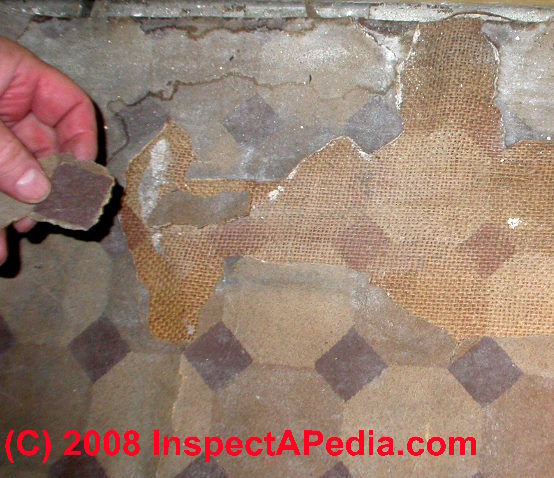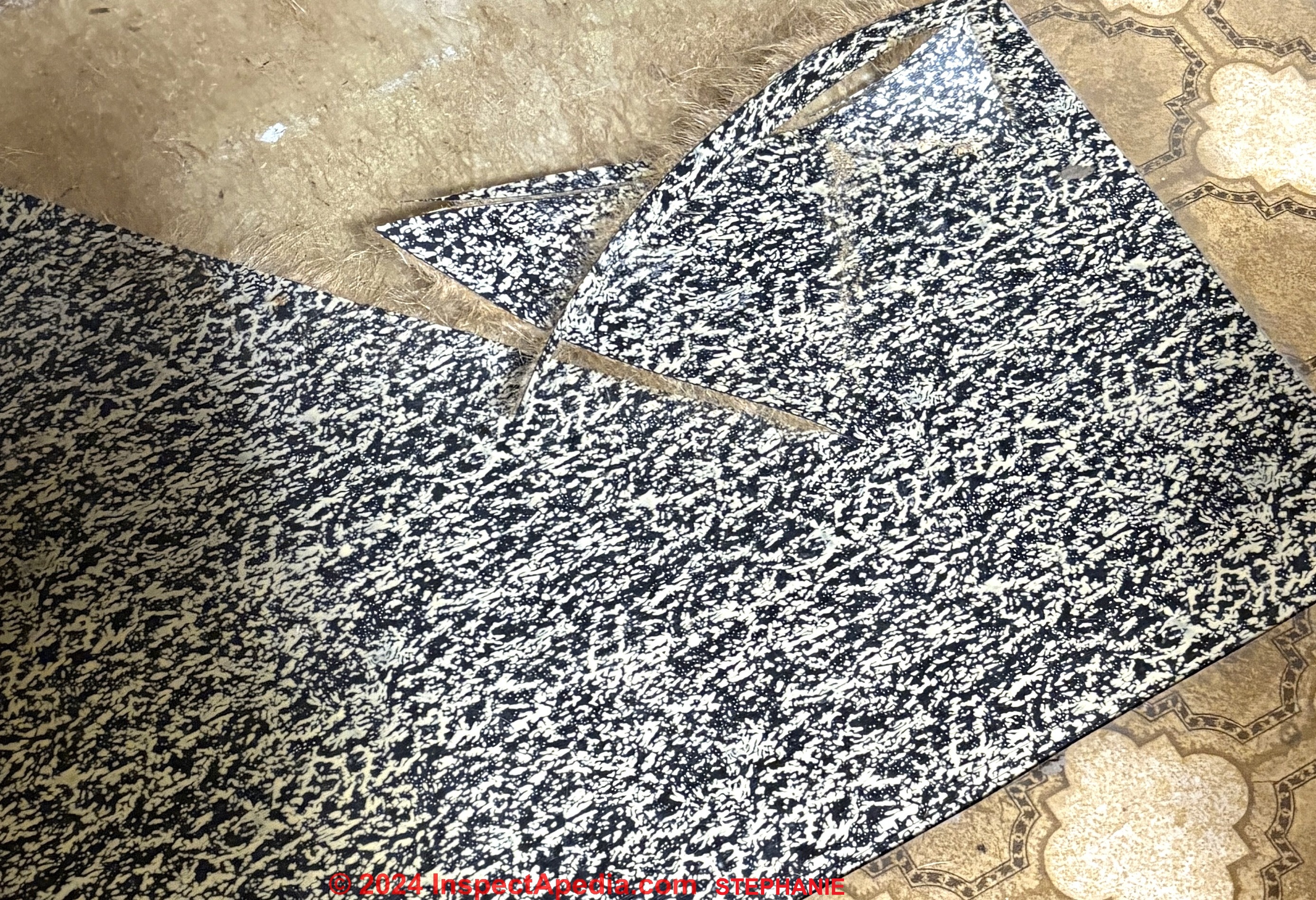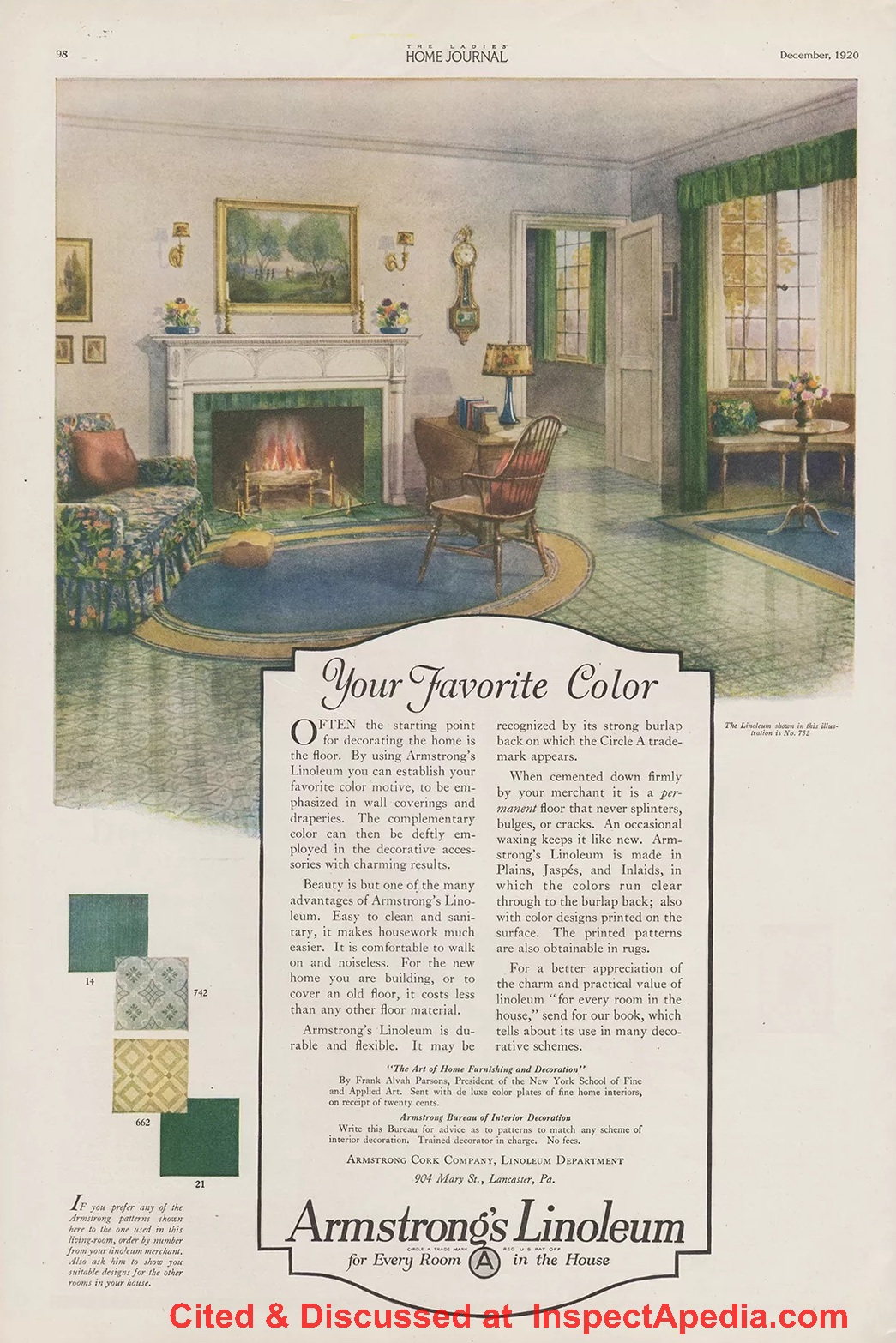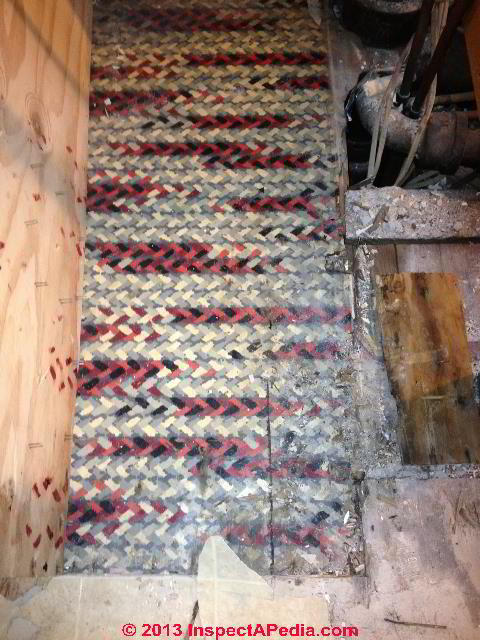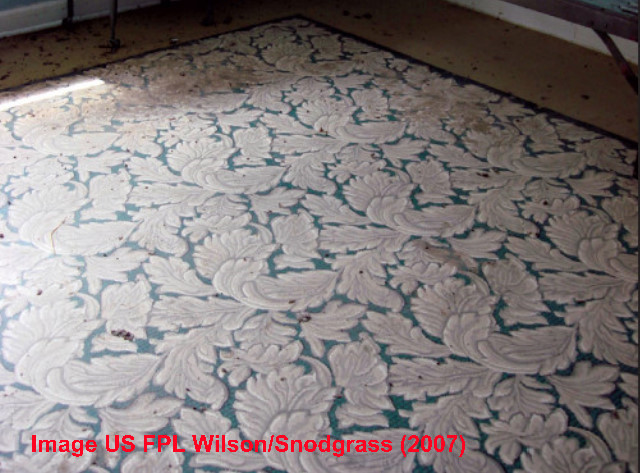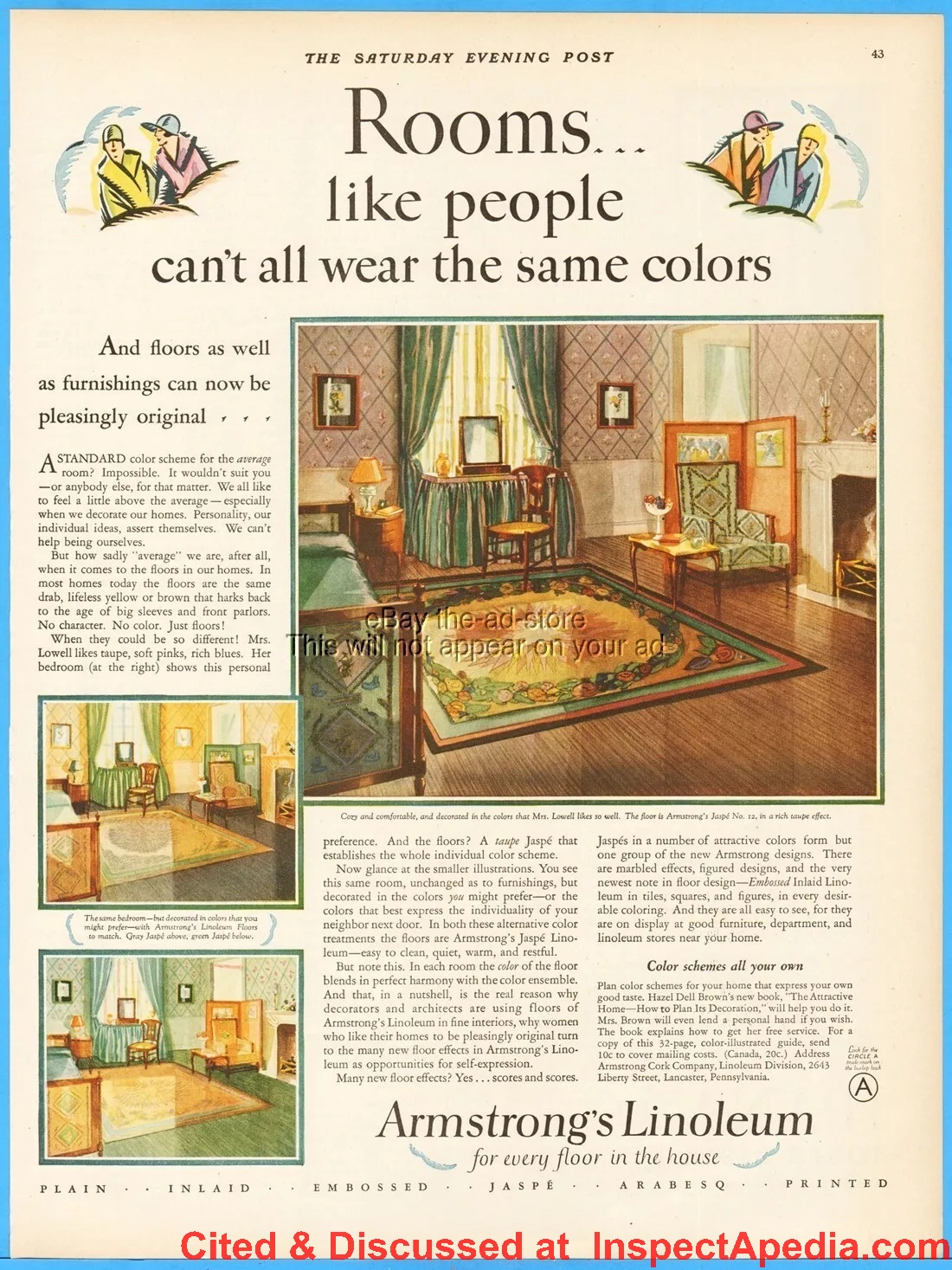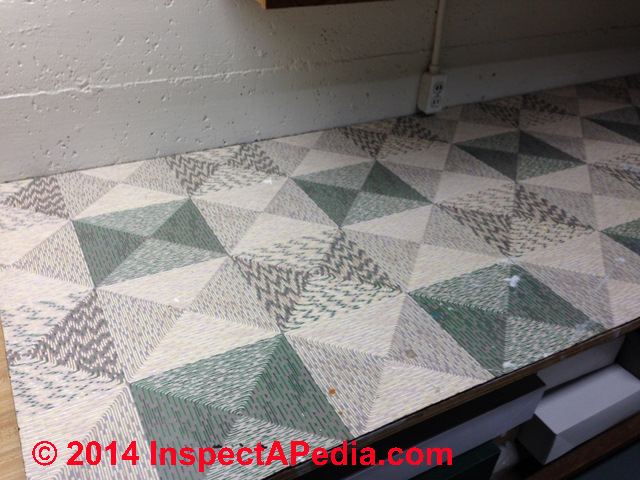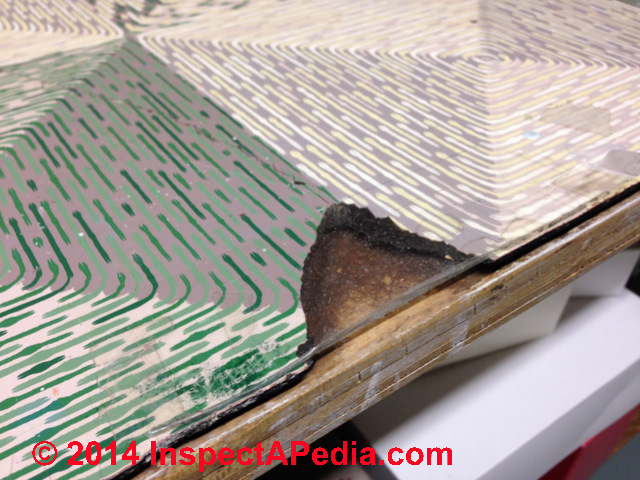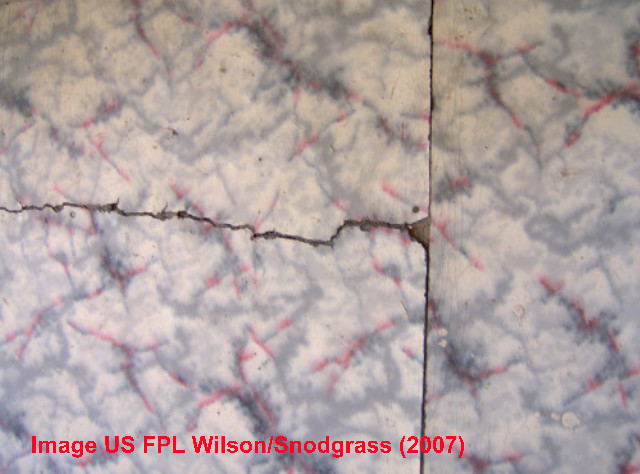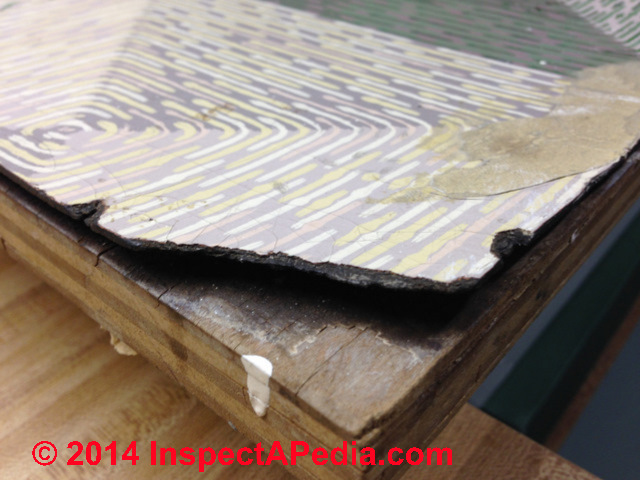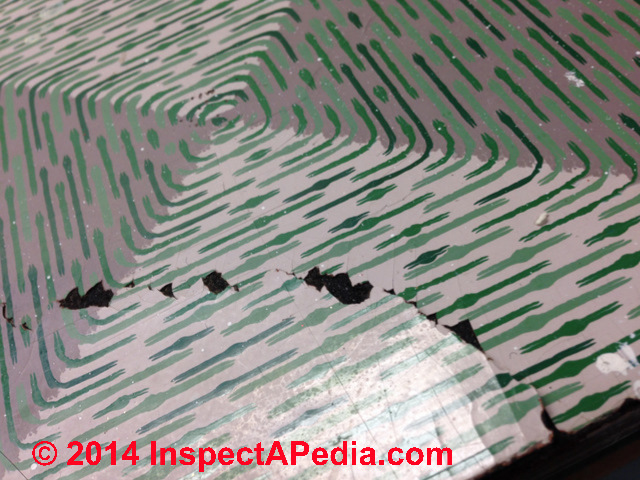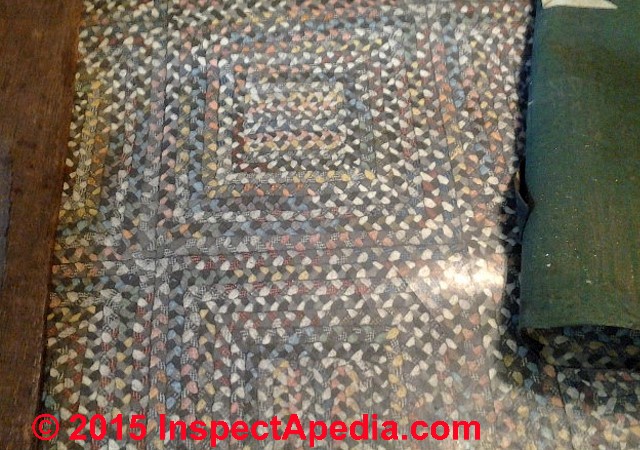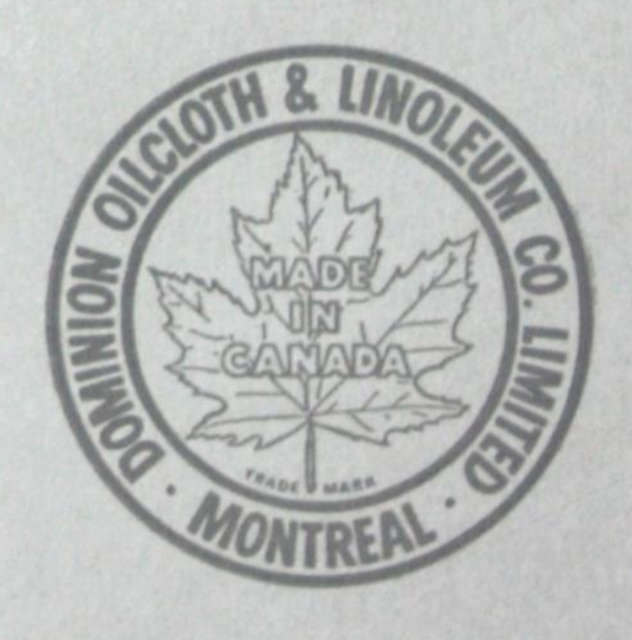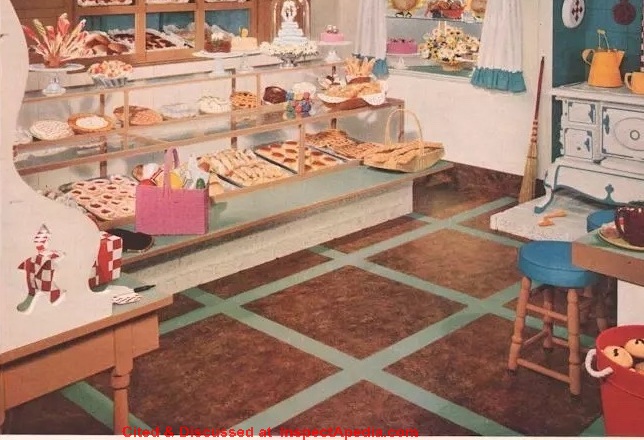 Linoleum Flooring Materials
Linoleum Flooring Materials
History, Components, Identification, Asbestos content
- POST a QUESTION or COMMENT about the history, uses, & ingredients in linoleum rugs or sheet or linoleum tile floor coverings
Linoleum Flooring Materials
History, Components, Identification: this article provides information about linoleum flooring: the history of linoleum, linoleum ingredients, and the properties of linoleum resilient or sheet floor coverings.
Page top: an Armstrong linoleum floor from a 1953 magazine advertisement. Click the image to see the full advertisement page.
InspectAPedia tolerates no conflicts of interest. We have no relationship with advertisers, products, or services discussed at this website.
- Daniel Friedman, Publisher/Editor/Author - See WHO ARE WE?
Linoleum Floor Covering Materials: history, ingredients, uses
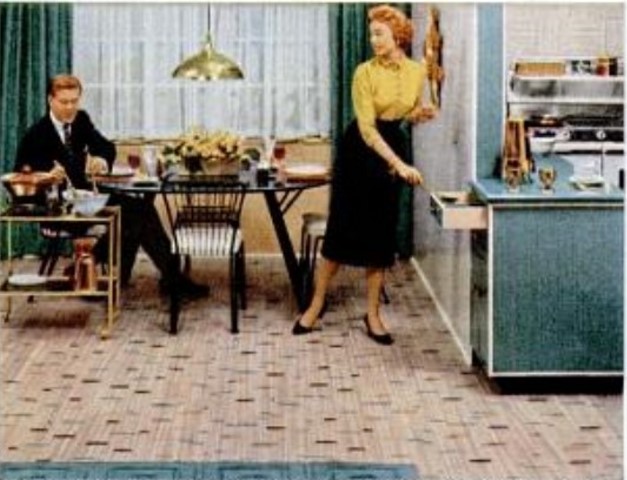 Linoleum was invented in 1860 by Frederick Walton and was intended for use first as a ship deck covering (battleship linoleum up to 1/2" thick).
Linoleum was invented in 1860 by Frederick Walton and was intended for use first as a ship deck covering (battleship linoleum up to 1/2" thick).
Earlier, in the 1700s, non-woven floor coverings were made of oil cloth - heavy canvas coated with wax or oils (for water resistance and durability) that were then painted.
Previously, painted oilcloth floor covering was probably the most common non-woven floor covering for nearly two hundred years, or until Walton's linoleum entered production.
Photo: Congoleum "Linoleum" from the company's 1958 flooring catalog.
Article Series Contents
- FLORAL PATTERN LINOLEUM & SHEET FLOORING - separate article
- LINOLEUM FLOOR HISTORY
- LINOLEUM ASBESTOS CONTENT? - separate article
- LINOLEUM, ASBESTOS FREE - Congoleum Gold Seal & Others
- LINOLEUM FLOOR INGREDIENTS
- LINOLEUM FLOORING RESTORATION & REPAIR - Conservation resources, separate article
- LINOLEUM "LOOKALIKES" ADHERED to FELT
Inventor & History of Linoleum Flooring & Its Descendants Lincrusta & Anaglypta
 Our photo illustrates sheet flooring uncovered by reader JH in a 1920's apartment.
JH was worried that this flooring might contain asbestos. Subsequent tests did not find asbestos in this floor sample.
Our photo illustrates sheet flooring uncovered by reader JH in a 1920's apartment.
JH was worried that this flooring might contain asbestos. Subsequent tests did not find asbestos in this floor sample.
Linoleum was the first modern, democratic floor covering.
This invention – patented in 1863 by a Scot, Sir Frederick Walton – had a revolutionary impact.
From the late 19th century right up until the 1950s, it was one of the few products which was simultaneously practical, hardwearing, non-flammable, low-maintenance and cheap.
Before the advent of linoleum, the only available floor coverings for homes or communal buildings were wood or tiles.
In the early 20th century, about one hundred factories were combining natural materials (linseed oil, jute, cork and pigments) to make linoleum by the square meter. (Tarkett ret. 2018)
Because of its durability and ease of production, Sir Walton's linoleum quickly found use as a floor coverings in buildings - a much larger application than battleships.
Linoleum's appeal rose from its properties as a durable, water-resistant sheet-type floor covering. Glued to a backer of jute or canvas to resist cracks and tears, this flooring has a long history of durability and service.
"Linoleum" was named by Walton from his observation that his original linoleum products were made using linseed oil as an ingredient (linseed oil forms a thick flexible skin when it dries), combined with ground cork dust, pigments, and resins, often with a jute, burlap or canvas fabric backing (see our antique linoleum photos just below).
Descendents of Linoleum include Anaglypta and Lincrusta (many writers spell it "Linocrusta or linacrusta"), an embossed patterned covering used on walls and ceilings.
Walton was also the inventor of a textured sheet
product LINCRUSTA CEILINGS & WALLS.
Our photo at below shows antique sheet flooring found in a home built in the 1800's.
Thomas Palmer, who had worked for Walton, soon produced a similar but lighter
sheet product ANAGLYPTA CEILINGS & WALLS.
Besides linseed-oil based linoleum flooring, other sheet floorings backed with jute or asphalt-impregnated black paper typically were composed of mostly cellulose (wood fiber or paper products) (60%) with a bit of horsehair (5%) for strength, and tar.
While people often refer to those pre-vinyl sheet flooring products as "linoleum" in a true sense of ingredients they're not.
Watch out: some asphalt-felt or black tar paper-like backed sheet flooring products might contain asbestos, as we'll explain next.
From a 1940s home in Germany, our reader, Stephanie, sent us these photos showing a 'hairy' backing bonded to black and white linoleum-like sheet flooring.
This backer, probably added to provide a softer or more-quiet resilient form of linoleum sheet flooring looks like a brown jute fiber, a plant-based material, not containing asbestos.
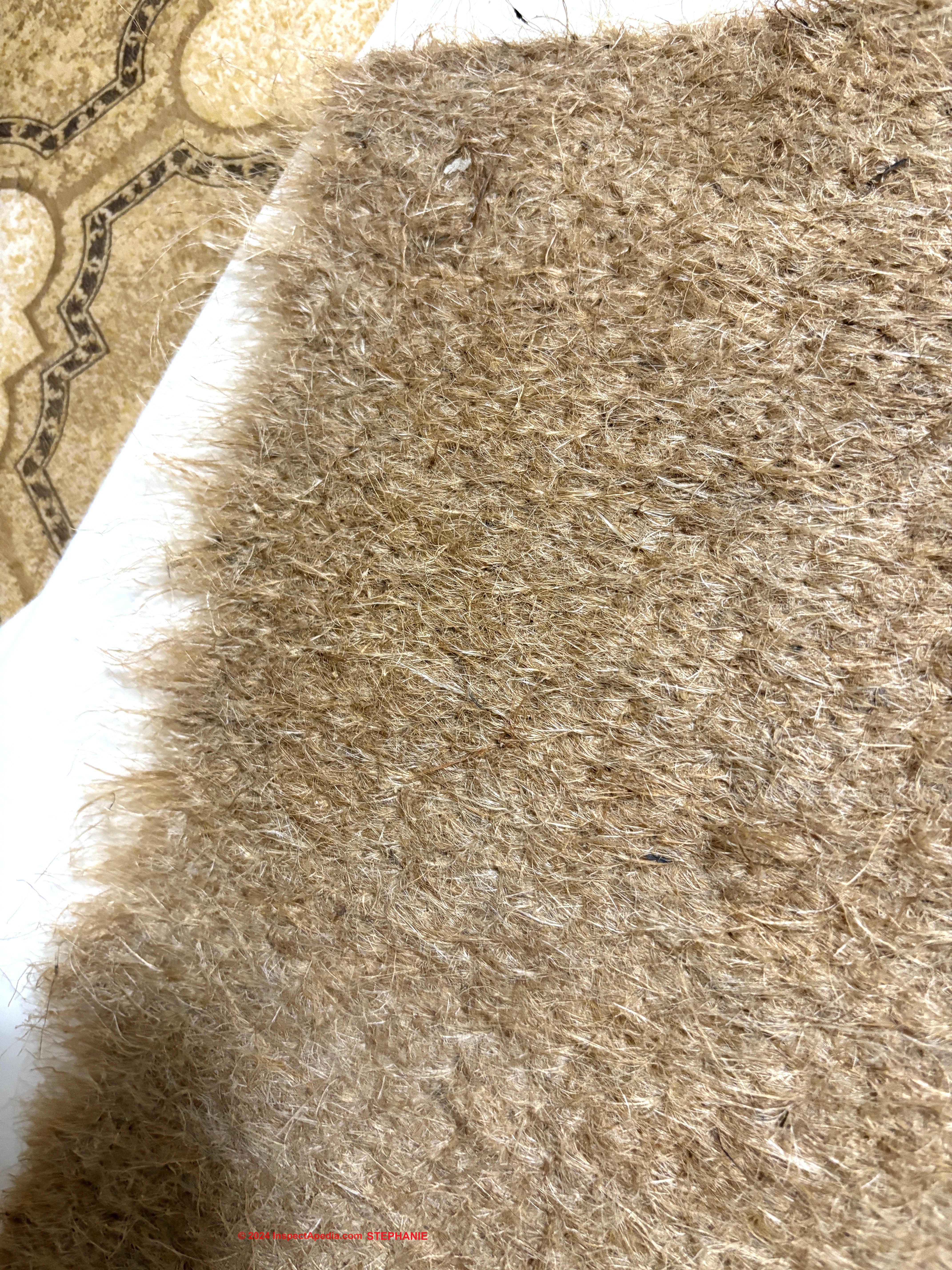
The black and white linoleum flooring itself (shown below) or more-likely its asphalt-impregnated backer and the adhesive used to adhere the linoleum to its jute-like backing could contain asbestos though not in a friable form.
See our discussion at ASBESTOS-CONTAINING MASTIC DANGEROUS?
At BURLAP / JUTE - BACKED SHEET FLOORING you can see our more detailed discussion of the flooring shown above.
Linoleum's ingredients, both historical and modern, rug patterns & other designs
Above: an Armstrong Linoleum advertisement from the December 1920 edition of the Ladies Home Journal Magazine.
The reader-contributed photographs just below demonstrate Congoleum's Gold Seal™ linoleum in a braided rug design or pattern. Below we list the ingredients found in linoleum floor coverings.
Because of its solid red color we wondered if this Gold Seal Congoleum product was a rubber-backed flooring product.
Help in distinguishing sheet flooring types is
at RESILIENT SHEET FLOORING ID GUIDE and
at SHEET FLOORING INSPECT / TEST.
Here are the ingredients in true linoleum:
- Natural resins: linseed oil (original linoleum), also balsam and copal resins or as a substitute dammar resin. Resins form the binder or "glue" that holds the product together. Linseed oil is made from flax seeds.
- Jute is used as the flooring backer for strength and dimensional stability.
As a kid we called jute "burlap" as it was commonly used also to produce burlap bags.
Jute is a natural fabric. We also have found older linoleum floor coverings that used asphalt-impregnated paper ("tar paper" or roofing felt) as a backer. - Color pigments are used to form the patterns in the linoleum surface (see our photos here).
Armstrong points out that their Armstrong DLW Linoleum, care was given to choice of pigments to protect the "natural" claim for this flooring material. Quoting:
In the Armstrong DLW Linoleum all the colour pigments are free of lead, cadmium and chrome.
The dark colours are produced for the most part with iron oxide pigments, the bright colours with pigments of organic origin. All pigments were examined by a toxicologist and are classified as being physiologically harmless.
Among other requirements Armstrong DLW Linoleum therefore meets the demands of the toy norm EN71 or better and the various legal requirements for the colouring of consumer goods. - [1]
Photo above: Congoleum "Linoluem" rug in a green and white floral pattern.
- Cork powder is used in Linoleum to give body to the flooring flexible surface.
Armstrong uses cork powder waste. Readers familiar with the Iberian peninsula will recognize that cork is a long-standing and important export product from both Spain and Portugal.
The "linoleum" photo at left in rug pattern (notice that the sheet flooring does not extend fully to the room perimeter) illustrates a linoleum "rug". Source: Wilson & Snodgrass, U.S. FPL (2007).
This rug pattern sheet flooring is discussed in detail
at CONGOLEUM-NAIRN FLOOR TILES & LINOLEUM.
and more examples of the floral linoleum pattern above are given
at FLORAL PATTERN LINOLEUM & SHEET FLOORING
CORK FLOORING also uses ground cork, but in a more coarse form described in that article.
- Limestone powder is used as a filler in the resilient linoleum floor covering body.
Really? Pending further research our GUESS is that some early forms of linoleum could have used asbestos powder as a similar filler material, just as asbestos powder was used as a filler in some floor tiles.
See ASBESTOS FLOORING IDENTIFICATION
where we pose 5 questions that can help make a reasonable guess at whether or not a specific flooring product contains asbestos before a lab test. - Wood powder (see cork above) is also used as a filler and body component of linoleum.
Below: Armstrong Linoleum advertisement from a 1927 edition of the Saturday Evening Post.
Linoleum "lookalikes" Adhered to Asphalt Felt Underlayment or green, red, or black backings
Identify Older Linoleum Rug or Black-Asphalt-Backed (dark felt underlayment-backed) Sheet Flooring
Photos of saturated felt-backed "linoleum" flooring (installed on a bench top) were provided by reader C.W.
In addition to use on floors, linoleum was a popular covering for workbenches and kitchen counters and sink draining areas.
Reader Question: linoleum sheet flooring in rug pattern used on work bench
I wanted to seek your advice on the attached images which is some sort of tiling that a previous homeowner put on a work bench as a covering.
I looked through your website, but couldn't find a match. Does this look like asbestos tiles to you? If so, any idea on the brand? Thanks in advance! - C.W. 1/17/2014
Reply: forms of "linoleum" may include products glued to felt underlayment vs. glued to a jute backing
Our guide to identifying older types of sheet flooring, including products that may contain asbestos, is found
at RESILIENT SHEET FLOORING ID GUIDE. There we describe some simple tests that can often confirm the flooring type and basic materials.
From your photographs (the pair above and second pair given below) showing that the flooring product, now covering a workbench top, has a woven rug -patterned top layer over a black substrate or backer, I would guess that this is an asphalt felt paper-backed sheet flooring product resembling linoleum.
The "linoleum" photo at left in a "marbleized pattern" illustrates a similar example of black felt-backed sheet flooring referred to by some experts as "linoleum". Source: Wilson & Snodgrass, U.S. FPL (2007).
We explain in this article that the ingredients of true linoleum include natural resins, linseed oil, color pigments, cork powder and limestone, with a jute backing. Those products do not contain and never contained asbestos.
But other sheet flooring products loosely called "linoleum" may indeed contain asbestos. The US Forest Products Lab asserts that some forms of "linoleum" were glued to felt underlayment. (US FPL 2007).
The black backing and body of the flooring in your photos looks to me like an asphalt product, though I'd have to see and test a sample to know for certain.
Photos above and below, show felt-backed "linoleum" provided by reader C.W.
Watch out: some older felt underlayments and similar asphalt paper products used in flooring, roofing, and wall coverings or building papers contained asbestos. While I'm doubtful that the small quantity of flooring in your photo presents a measurable asbestos hazard (unless some fool grinds or rips it into shreds), it may thus contain asbestos.
If this asphalt-felt backed antique flooring sample were mine I'd preserve it, or a square of it, as it may be historically important.
Your second photo of the four (above right) seems to show a plastic or glass cover over this sheet flooring "rug" (as they were called). In that installation the material is protected and most likely completely harmless.
If you decide to dispose of the material as construction debris, I'd be glad to have you cut a pattern square and send it to me for lab examination pro-bono.
While we have expertise in asbestos and other material identification in our forensic lab, if you needed an asbestos certification (which in my opinion would be inappropriate for this case) you'd want to use a certified asbestos test lab.
Reader Question: Not sure if this rub-pattern sheet flooring contains asbestos or not. Rug pattern sheet flooring with green backing
They are old - the kind that last a long time! The fleck type one was under several layers of flooring in my grandparents home. I think they built it around 1935.
[Click to enlarge any image]
The second one, [shown immediately above] the rug pattern is the one I am most interested in finding out about. The backing is green but I cannot find a makers mark on it. Any idea if that means anything? - Anon [by private email] 23 Aug 2015
Reply:
The photo shown just above looks like a rug pattern linoleum and if the green rolled material in the right of your photo is the same flooring, it is more likely a Congoleum (or less likely Armstrong) sheet flooring product.
Some Congoleum sheet flooring and also some Armstrong sheet flooring included a red or possibly green rubber backing that is not an asbestos material.
If you can examine the backing of this sheet flooring there is a good chance you'll see an Armstrong or Congoleum imprinted logo - do send me a photo of what you see.
Red backed sheet flooring by Congoleum is a rubber backing (not asbestos); green-backed sheet flooring is probably a similar product; asphalt felt paper (some of which can contain asbestos) would normally be black (as it's an asphalt product).
IF you are faced with a requirement for demolition and if you are uncertain about the flooring's asbestos content and cannot identify it through our guides, then you have a sample tested.
See ASBESTOS TESTING LAB LIST and as it will help other readers, if you have this flooring tested please confirm the lab result with us and send me a copy of the lab report.
Reader Question: what is this sheet flooring from my home that was built in 1865?
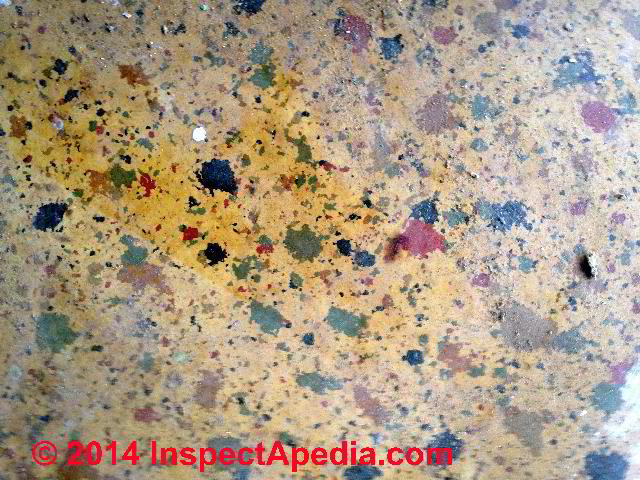 Can you give me an idea of date or asbestos?
Can you give me an idea of date or asbestos?
House was built 1865.
Several layers.
This one is the last on top of tongue and groove.
Black felt backing. With asphalt type adhesive.
Thank you. - L.P. 6/3/2014
Reply:
LP this looks like a linoleum floor to me.
The spatter pattern was later picked-up and popularized in a similar (not identical) design that appeared in some of the Kentile flooring as
its CARNIVAL PATTERN but those were individual floor tiles, not sheet flooring like yours.
See my warning above about some older felt backing and some flooring adhesives that contain asbestos.
Canadian Linoleum Floor Coverings: Dominion Sheet Linoleum & Floor Tiles
This topic has moved to a separate page now found
at DOMINION & Other CANADIAN FLOORING ASBESTOS
Is there Asbestos in "Linoleum"?
Moved to
- LINOLEUM ASBESTOS CONTENT?
- LINOLEUM, ASBESTOS FREE Congoleum Gold Seal & Others
Modern Linoleum Flooring
Moved to MODERN LINOLEUM FLOORS - separate article
Where to Buy Modern Linoleum Flooring & Linoleum Flooring
Moved to WHERE TO BUY LINOLEUM, RUBBER, CORK FLOORS
How to Identify Armstrong, Congoleum, & other Asbestos-Containing Resilient Sheet Flooring
Details about identifying older installations of sheet flooring or sheet-forms of resilient flooring that may contain asbestos are now found at RESILIENT SHEET FLOORING ID GUIDE - live link is given just below.
Armstrong's sheet flooring is described at ARMSTRONG SHEET FLOORING
Linoleum Floor Restoration & Care Advice
MOVED to LINOLEUM FLOORING RESTORATION & REPAIR - Conservation resources
...
Continue reading at LINOLEUM ASBESTOS CONTENT?, or select a topic from the closely-related articles below, or see the complete ARTICLE INDEX.
Or see LINOLEUM & SHEET FLOORING FAQs - questions and answers posted originally on this page.
Or see these
Recommended Articles
- ASBESTOS FLOORING HAZARD REDUCTION
- ASBESTOS TESTING LAB LIST
- ARMSTRONG RUBBER BACKED RUG PATTERNS
- ARMSTRONG SHEET FLOORING 1940 - 1980
- CONGOLEUM-NAIRN FLOOR TILES & LINOLEUM
- DOES THIS FLOORING CONTAIN ASBESTOS? - 5 easy questions help make a reasonable guess -
- DOMINION & Other CANADIAN FLOORING ASBESTOS
- FLOOR COVERINGS: 1900 - 1949
- FLOOR, RESILIENT VINYL or CORK
- IDENTIFY SHEET FLOORING TYPE
- LINOLEUM & OTHER SHEET FLOORING
- FLORAL PATTERN LINOLEUM & SHEET FLOORING
- LINOLEUM FLOOR HISTORY
- LINOLEUM ASBESTOS CONTENT?
- LINOLEUM, ASBESTOS FREE Congoleum Gold Seal & Others
- LINOLEUM FLOOR INGREDIENTS
- LINOLEUM FLOORING RESTORATION & REPAIR - Conservation resources
- LINOLEUM "LOOKALIKES" ADHERED to FELT
- MODERN LINOLEUM FLOORS
- WHERE TO BUY LINOLEUM, RUBBER, CORK FLOORS
- RESILIENT SHEET FLOORING ID GUIDE
- SHEET FLOORING POSSIBLE ASBESTOS - 1960-1987
- SWEDISH TARKETT FLOORING POSSIBLE ASBESTOS
Suggested citation for this web page
LINOLEUM & SHEET FLOORING at InspectApedia.com - online encyclopedia of building & environmental inspection, testing, diagnosis, repair, & problem prevention advice.
Or see this
INDEX to RELATED ARTICLES: ARTICLE INDEX to BUILDING FLOORING
Or use the SEARCH BOX found below to Ask a Question or Search InspectApedia
Or see
INDEX to RELATED ARTICLES: ARTICLE INDEX to BUILDING INTERIORS
Or use the SEARCH BOX found below to Ask a Question or Search InspectApedia
Ask a Question or Search InspectApedia
Questions & answers or comments about linoleum floor coverings, age, history, safety, materials, contents.
Try the search box just below, or if you prefer, post a question or comment in the Comments box below and we will respond promptly.
Search the InspectApedia website
Note: appearance of your Comment below may be delayed: if your comment contains an image, photograph, web link, or text that looks to the software as if it might be a web link, your posting will appear after it has been approved by a moderator. Apologies for the delay.
Only one image can be added per comment but you can post as many comments, and therefore images, as you like.
You will not receive a notification when a response to your question has been posted.
Please bookmark this page to make it easy for you to check back for our response.
IF above you see "Comment Form is loading comments..." then COMMENT BOX - countable.ca / bawkbox.com IS NOT WORKING.
In any case you are welcome to send an email directly to us at InspectApedia.com at editor@inspectApedia.com
We'll reply to you directly. Please help us help you by noting, in your email, the URL of the InspectApedia page where you wanted to comment.
Citations & References
In addition to any citations in the article above, a full list is available on request.
- Armstrong Cork & Tile Co., HOW TO LAY & CARE FOR LINOLEUM 1914 [PDF] 2nd Ed., Armstrong Cork & Tile Co, Linoleum Department, Lancaster PA
- Armstrong Cork Co., Armstrong's QUAKER and SETANDARD RUGS and FLOOR COVERING 1939 [PDF] availble at Building Technology Archive - Internet Archive - [Copy on file as Armstrongs-Quaker-And-Standard-Rugs-And-Floor-Covering-1939.pdf ]
- Armstrong Cork Co., Armstrong LINOLEUM PATTERN BOOK 1921 [PDF] - retrieved 2024/10/26, original source: https://ia801708.us.archive.org/19/items/armstrongslinole00arms/armstrongslinole00arms.pdf [Copy on file as Armstrong-Linoleum-Pattern-Book-1921.pdf ]
- Armstrong Cork Co., Armstrong's LINTOILE [PDF] - op. cit. [Copy on file as Armstrong's-Linotile.pdf]
Excerpt: Armstrong’s Linotile® is a beautiful resilient floor that offers ease of maintenance and durability unmatched by any other resilient ffooring material.
Manufactured exclusively by Armstrong since 1914, Linotile is a flooring of proved quality.
It is produced essentially from the same raw materials as linoleum, but a series of manufacturing processes make it a completely different flooring with distinctive qualities all its own. - Richa Wilson, Kathleen Snodgrass, " EARLY 20TH-CENTURY BUILDING MATERIALS: RESILIENT FLOORING " [Very large PDF], Richa Wilson, Intermountain Regional Architectural Historian Kathleen Snodgrass, Project Leader, United States Department of Agriculture Forest Service, Technology & Development Program, August 2007, 7300-0773-2322-MTDC. Contact Kathie Snodgrass at MTDC: Phone: 406–329–3922 Fax: 406–329–3719 E-mail: ksnodgrass@fs.fed.us
- [1] Armstrong, Portugal: Ingredients of Linoleum, web search 03/31/2011, original source: http://www.armstrong.pt/commflreu/es-pt/ingredients.html
- America's Favorite Homes, mail-order catalogues as a guide to popular early 20th-century houses, Robert Schweitzer, Michael W.R. Davis, 1990, Wayne State University Press ISBN 0814320066 (may be available from Wayne State University Press)
- Armstrong ® Residential Flooring - Website 05/15/2010 https://www.armstrongflooring.com/ lists current flooring products provided by the Armstrong Corporation, including Armstrong's current vinyl floor tile products at https://www.armstrongflooring.com/flooring/products/vinyl-floors
- Armstrong Corporation, Corporate History - armstrongflooring.com/corporate/corporate-history.html - Web Search 05/19/2010
- Armstrong vinyl asbestos floor tiles: photos of asbestos floor tiles as catalog pages (PDF form) are at www.asbestosresource.com/asbestos/tile.html
- Thanks to reader Robin DiNunzio for contributing samples of cork flooring from a 1949 home M1y 2010
- In addition to citations & references found in this article, see the research citations given at the end of the related articles found at our suggested
CONTINUE READING or RECOMMENDED ARTICLES.
- Carson, Dunlop & Associates Ltd., 120 Carlton Street Suite 407, Toronto ON M5A 4K2. Tel: (416) 964-9415 1-800-268-7070 Email: info@carsondunlop.com. Alan Carson is a past president of ASHI, the American Society of Home Inspectors.
Thanks to Alan Carson and Bob Dunlop, for permission for InspectAPedia to use text excerpts from The HOME REFERENCE BOOK - the Encyclopedia of Homes and to use illustrations from The ILLUSTRATED HOME .
Carson Dunlop Associates provides extensive home inspection education and report writing material. In gratitude we provide links to tsome Carson Dunlop Associates products and services.


